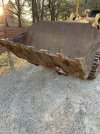Voodooburner
Well-Known Member
I have several rutted roads I would like to smooth out. Seems to me the best way would be to lower the bucket, tilted down and drag backwards using the weight of the machine. Problem is my bucket has teeth that will wreck the road, the bottom of the bucket is too flat and smooth to really make a dent in it. Should I remove the teeth? Maybe some other technique? I have no clue what I am doing with this thing but I am having a pant-load of fun doing it. 28,000lb Komatsu d-41s

